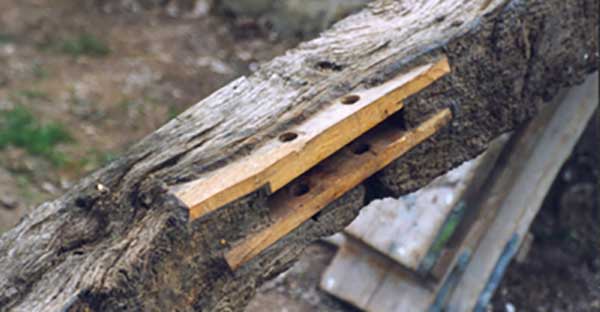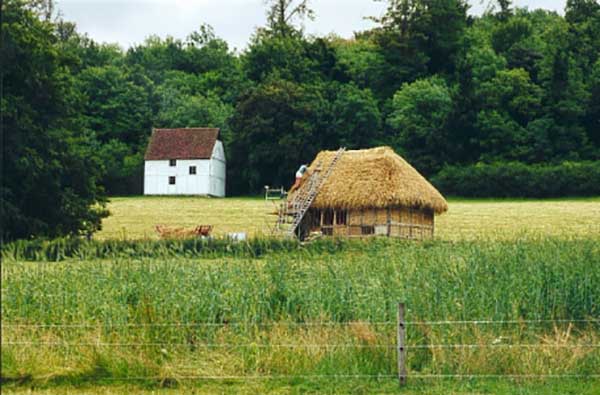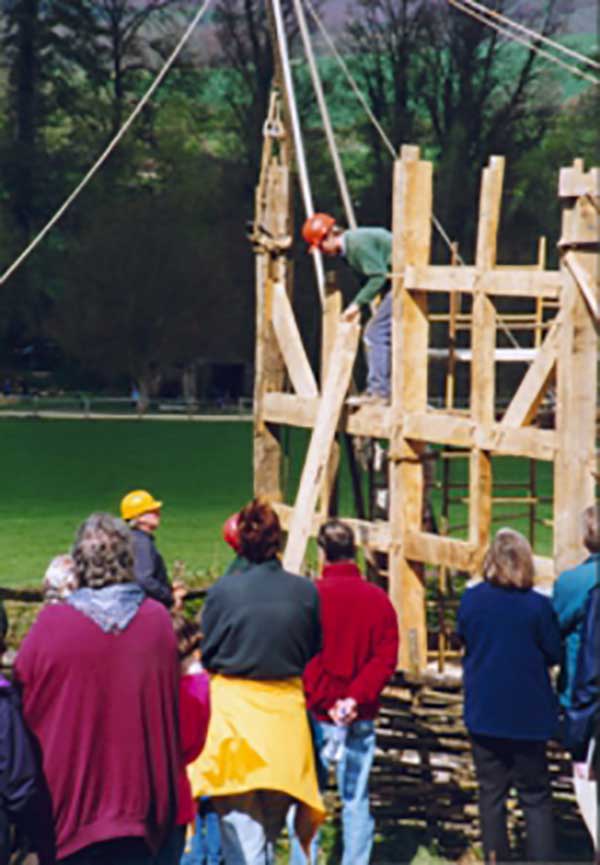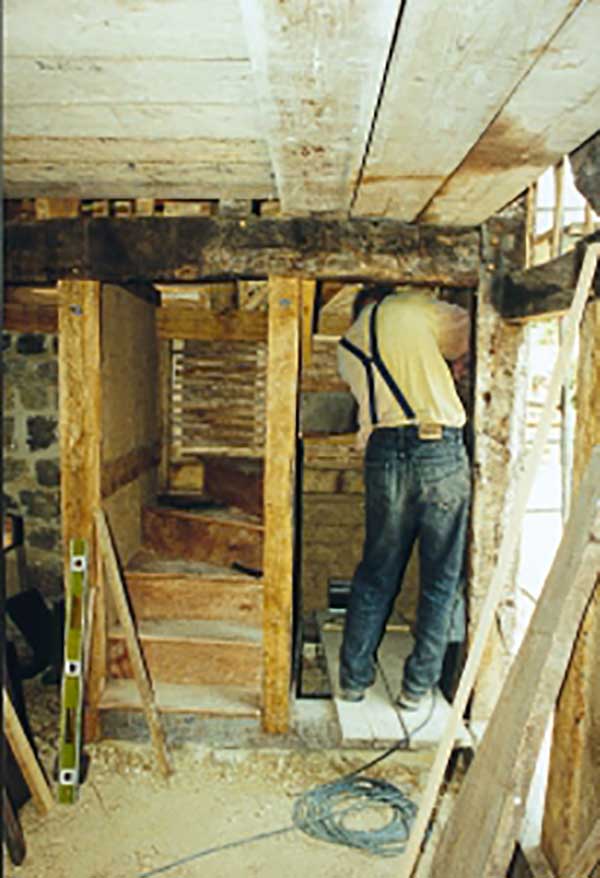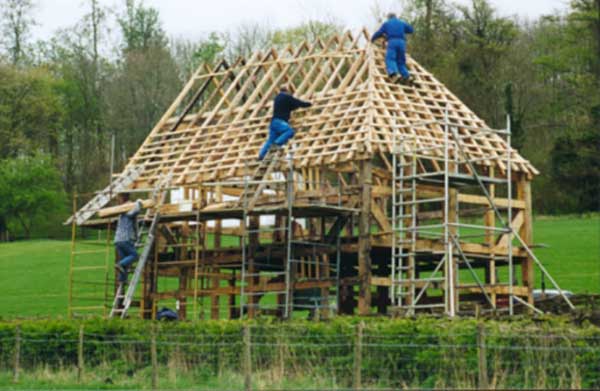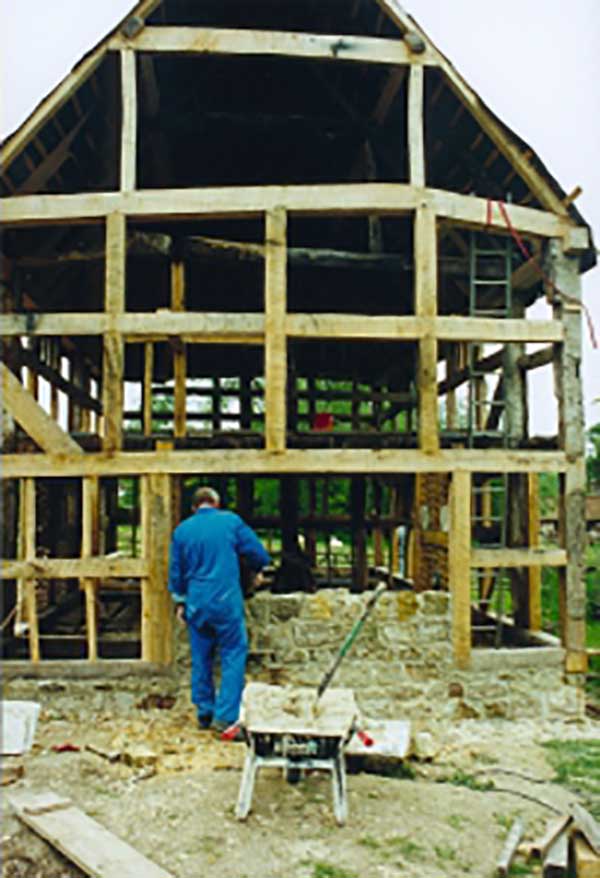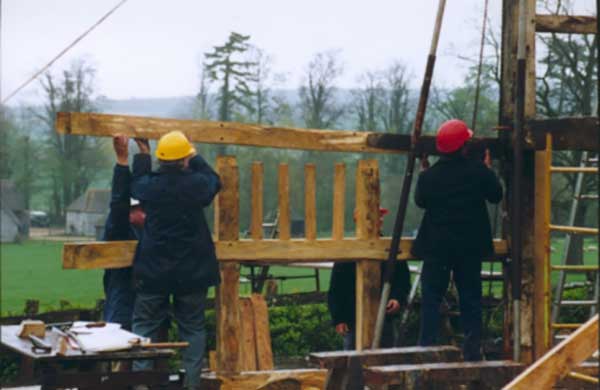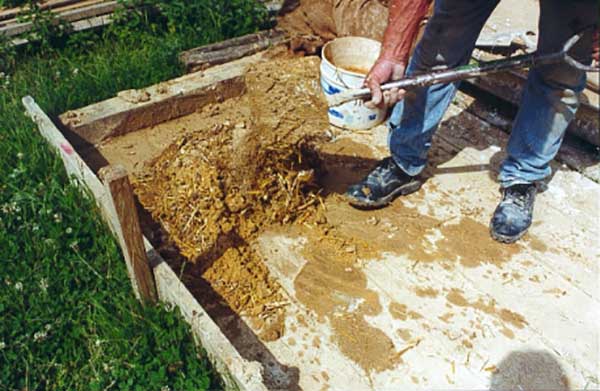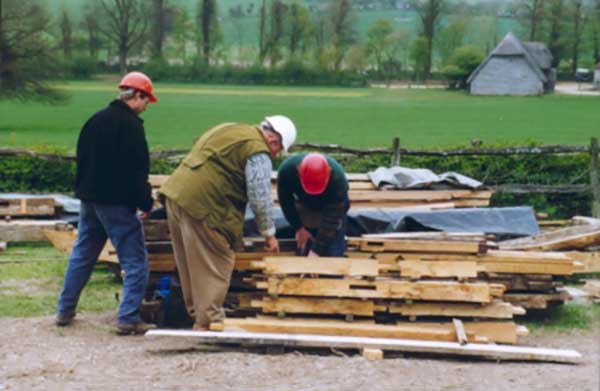
This building was probably the home of a landless labourer, possibly a craftsman. It was built in the mid-17th century on the edge of Washington Common. It has one heated room, and the fireplace is in a smoke bay, an early form of chimney.
Poplar Cottage cannot be precisely dated but from the style and details of its construction it was probably built in the mid 17th century, or possibly a little earlier. It occupied a small plot of land on the southern edge of the common at Washington, near Steyning in West Sussex.
Archaeology carried out after the building was dismantled in 1982 showed that there had not been a previous building on the same site.
Share
Overview
Dates From
Mid 17th century
Dismantled
1982
Reconstructed
1999
Original Location
Washington, Sussex
Building History
Encroachments on ‘Wasteland’
Encroachments on ‘wasteland’ — usually the edges of roads or commons — became widespread during the period c.1580–1650. Such encroachments were sometimes made with manorial approval, but in other cases were illegal and had to be removed. They were the consequence of the pressure on land due to demographic growth and the increasing proportion of the rural population dependant on wages.
Cottages like Poplar were the homes of landless or near-landless husbandmen, labourers and craftsmen, for whom the commons were an important resource, if only to pasture a cow or gather fuel.

Poplar Cottage on its original site before dismantling in 1982.
The Building Plan
In plan the building has two rooms on the ground floor and two chambers above. Only one room is heated, and this would probably have been called the hall. The second ground floor room would have been used as a service room and was perhaps referred to as the ‘shop’, while the two upstairs rooms would have been used as bedrooms.
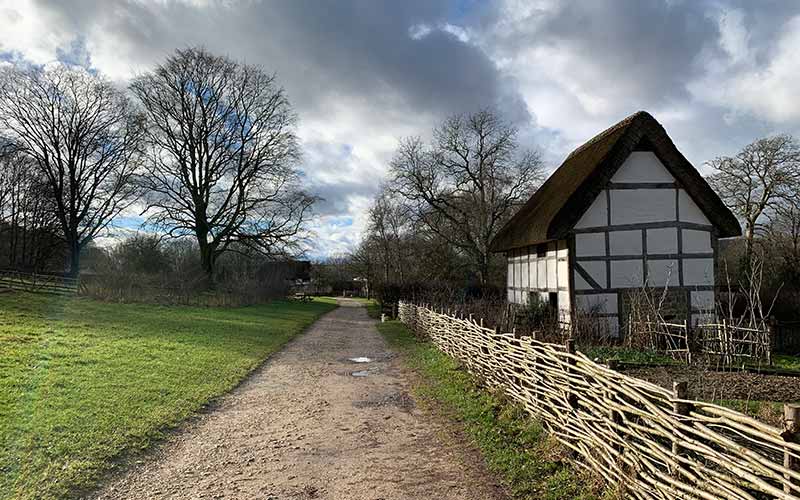
Instead of a chimney, the fire burns in a ‘smoke bay’ at the gable end of the cottage. In this arrangement, a small bay about four feet long contains the smoke from the fire. It was an intermediate stage of development between the open hall, in buildings such as Bayleaf and full chimneys in houses like Pendean.
Smoke bays were first identified by researchers in Surrey and are common in 16th and 17th century houses in the Weald and Downland region.

In the 18th century a brick and stone chimney was built within the smoke bay and an outshot was added to the back of the building, but otherwise the pattern of life in the cottage must have remained much the same for more than three hundred years.
Article: A Wasteland Cottage from Washington
Poplar Cottage – A Wasteland Cottage from Washington, West Sussex by Dr Danae Tankard
Poplar Cottage, from Washington in West Sussex, is a building of a distinctive type, with two rooms on the ground floor, two rooms above and with a smoke bay at the gable end and a hipped terminal at the opposite end. A smoke bay – a small bay which contains smoke from the fire – is an intermediate stage of development between the open hall and full chimneys.
The date range for smoke-bay houses and cottages is from the early 16th century to the mid 17th century but the style of timber framing used for Poplar suggests that it was probably built towards the end of that period, possibly between 1630 and 1650. About 50 to 100 years later a brick and stone chimney stack was built inside the smoke bay and probably about the same time an outshot was added to the back.
David and Barbara Martin have identified Poplar Cottage as a wasteland cottage, that is, a landless, or near-landless, cottage built either on a wayside verge or as an encroachment on common land. Poplar was built on the edge of Washington Common, on what seems to have been the boundary of Washington and Chancton manors, a point which will be returned to later.
Wasteland cottages were relatively rare in the late 15th and early 16th centuries but became common throughout the Weald and Downland region during the period 1580 to 1650, and may have accounted for about 15% of all rural housing by the second half of the 17th century.
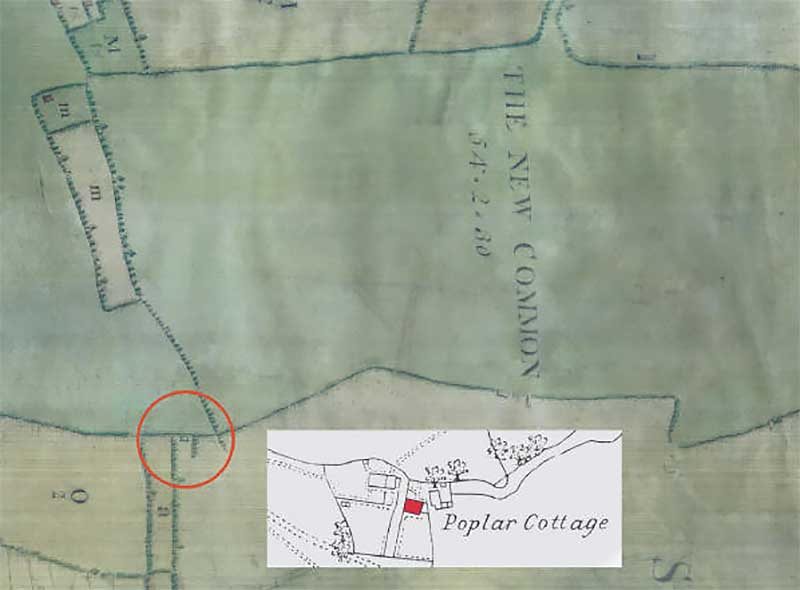
Poplar Cottage (circled in red) as shown on a map of c.1739, on the southern boundary of Washington Common. Inset, detail based on the OS 1st edition 25in = 1 mile map, showing Poplar Cottage (red).
The evidence from standing buildings, which undoubtedly represent only a tiny proportion of the actual number built, together with the documentary evidence, suggest that the late 16th and early 17th centuries saw an unprecedented explosion in cottage building.
This was a response to the social and economic pressures of the period, which witnessed a rapid growth in population, putting pressure on land, the existing housing stock and opportunities for employment.
An increasing proportion of the rural population became landless or near-landless, partially or wholly dependent upon wages, and subject to seasonal periods of under- or unemployment.
Common Land
Common land refers to the non-arable and unenclosed parcels of land on a manor such as wastes, woods and pasture. It was owned by the manorial lord but the tenants had the right to its natural products – for food, fuel and materials – and to pasture their animals.
However, not everyone had equal rights to the use of common land. Common rights went with tenure, with some tenants entitled to a greater share of common resources than others. The use of common land was governed by manorial custom and regulated through the manorial courts.
Manorial courts could qualify customary entitlements further through the issuing of ordinances or by-laws, restricting the use of commons to certain times of the year, the number and type of animals that could be pastured, or the amount of material that could be taken at any one time.
Tenants who took more than their entitlement, or who otherwise infringed custom or ordinance, were presented in the manorial courts and fined.
The landless – squatters, inmates and their tenants – had no legal rights to the exploitation of common land, although in practice they might be allowed unofficial ‘use rights’, such as the gathering of fuel, or the pasturing of a cow. The exercise of common rights could form a substantial part of the income of the poor.
It has been estimated that in the 18th century the pasturing of a single cow on common land might constitute as much as 40% of an agricultural labourer’s income and fuel rights could have been worth between 10 and 20% of earnings. Income derived in this way could allow a family to remain self-sufficient rather than become dependent upon parish rates.
For this reason, although tenants were assiduous in guarding their common rights, they would tolerate unofficial use by those who might otherwise become a financial burden on the parish, for which they would all be liable.
The Regulation of Cottage Building in Late 16th & 17th Centuries
The problems caused by the illegal erection of ‘cottages’ on common land were explicitly recognised in 1589 when an act entitled ‘An act against erecting and maintaining cottages’ was passed. This stipulated that:
For the avoiding of the great inconveniencies which are found by experience to grow by the erecting and building of great numbers and multitude of cottages, which are daily more and more increased in many parts of this realm, be it enacted … that … no person shall within this realm … make, build and erect, or cause to be made, built or erected, any manner of cottage for habitation or dwelling, nor convert or ordain any building or housing made or hereafter to be made or used as a cottage for habitation or dwelling, unless the same person do assign and lay to the same cottage or building four acres of ground at the least, to be accounted according to the statute or ordinance De terris mensurandis being his or her own freehold and inheritance lying near to the said cottage, to be continually occupied and manured therewith so long as the same cottage shall be inhabited; upon pain that every such offender shall forfeit, to (the Queen) … £10 of lawful money of England for every such offence.
Exemption from the Act could be obtained by petition to the Quarter Sessions on grounds of poverty, provided the permission of the manorial lord was given. Lodgers (described as ‘inmates’) and the subdivision of houses were not allowed.
This was qualified by an act passed in 1601 entitled ‘An act for the relief of the poor’ (usually referred to as the Poor Law Act) which gave churchwardens and overseers authority to build cottages on ‘waste and common’ for the use of the poor, with permission of the manorial lord:
It shall and may be lawful for the said churchwardens and overseers … by the leave of the lord or lords of the manor, whereof any waste or common within their parish is or shall be parcel … according to any order to be set down by the justices of the peace of the said county at their general Quarter Sessions … to erect, build and set up in fit and convenient places of habitation, in such waste or common, at the general charges of the parish … convenient houses of dwelling for the said impotent poor.
A comparison of manorial records with the records of Quarter Sessions suggests that the majority of cases of illegal cottage building were dealt with by the manorial courts. Faced with an illegally erected cottage the manorial court might fine the cottager and order him or her to pull it down or grant the cottager licence to continue the cottage.
Cottages that were licensed by the lord became either copyhold or leasehold properties; in other words their inhabitants became legitimate tenants of the manor, paying an annual rent and subject to manorial custom.
Those indicted before the Quarter Sessions received similar treatment: they could be fined and ordered to pull the cottage down, or they could be given a licence, with the consent of the manorial lord, and allowed to continue it.
Licenses could be granted for a set period of time or in perpetuity. Evidence from both types of source material suggests that by the late 17th century the rate of illegal cottage building had declined markedly.
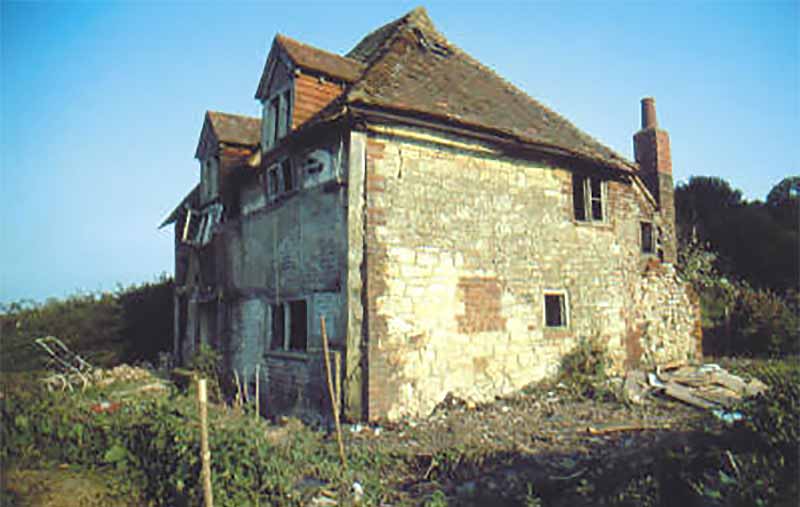
Poplar Cottage from the north west before dismantling.

Poplar Cottage viewed from the north before dismantling.

Left: Poplar Cottage during dismantling, showing the sooted wattle and daub remains of the side of the smoke bay built into the stonework of the later chimney. Right: The north-east corner of the cottage in situ.
The Manorial Status of Poplar Cottage
Poplar Cottage lay within the parish of Washington, which in the late 17th century had a population of about 400 to 450. Land in Washington was divided between two manors, Washington and Chancton, and both manors had rights of common on Washington Common, as well as having common land elsewhere within the parish.
The manorial status of Poplar Cottage has always been problematic to those attempting to research the history of the house. A map of the manor of Washington dated c.1739 shows the cottage set on its own on the edge of Washington Common and outside the boundary of the manor on land held by Sir Robert Fagg, lord of the neighbouring manor of Wiston.
Additional research has now established that in 1715 Fagg bought a chunk of the former demesne lands of Chancton manor from the lord of Chancton, James Butler. This chunk included 85 acres in the north of Findon and 70 acres in Washington. Although the exact bounds are unclear, the 70 acres appears to have comprised the land to the south of Washington Common (and so including Poplar Cottage), extending to the top of Chanctonbury Hill.
By the 19th century this land, and Poplar Cottage, had been incorporated into the Wiston estate, owned by successive members of the Goring family.
The court book for the manor of Chancton beginning in 1603 records several presentments in the manorial court in the early 17th century for the illegal erection of cottages on manorial waste. For example, in 1603 the court presented that ‘William Wilkin has encroached on a parcel of the lord’s waste called Washington Common and thereupon has built a certain cottage without licence’. And in 1605 five tenants were presented together for building cottages without licence on manorial waste and each fined 6s 8d, and ordered to pull their cottages down or face a further fine of 10s.
The earliest surviving court book for the manor of Washington begins in 1682 by which time there were at least half a dozen wasteland cottages, all copyhold properties. Such cottages can be identified either because they are described as ‘formerly part of the waste’ and/or because of their location on or besides manorial waste.
Cottages & the Status of Their Inhabitants
Despite extensive research it has not been possible to identify the earliest occupants of Poplar Cottage. However, a broader analysis of 17th century cottagers enables us to draw some conclusions about the occupants’ probable social and economic status. The requirement of the 1589 act that cottages must have at least four acres of land must have represented the minimum amount of land then thought necessary to sustain a family.
We know from the Washington tithe map and award of 1839 that at that date Poplar had 26 perches of land, which is about one sixth of an acre. The size of this holding (essentially a garden) has been recreated at the museum on the small plot of land on which Poplar Cottage is now situated.
Indictments before the Quarter Sessions for illegally erecting cottages which record the defendant’s status show that they were typically either husbandmen, labourers or craftsmen, with husbandmen forming the largest single group (reflecting the predominance of this group in rural society). Those granted licences either to erect or to continue cottages were typically, although not exclusively, paupers, reflecting the requirements of the 1589 act.
To put these social groups in context, in 1577 when William Harrison wrote his Description of England he divided the population into four ‘sorts’ of people, gentlemen, citizens or burgesses, yeomen and ‘artificers and labourers’. The last group Harrison described as ‘day labourers, poor husbandmen, and some retailers (which have no free land), copyholders, and all artificers, as tailors, shoemakers, carpenters, brickmakers, masons, etc’.
In terms of social status, Harrison’s ‘fourth and last sort’ were, however, above the level of the truly poor, whom Harrison divided into a further three ‘sorts’, the impotent poor, those who are poor ‘by casualty’ and the ‘thriftless poor’.
It is probable that the early occupants of Poplar Cottage were husbandmen, earning their living from the land. Since the land adjoining the cottage was clearly insufficient to sustain a family, the occupants are likely to have derived much of their household income from the exercise of unofficial use rights on Washington Common.
They may also have supplemented their income by working as agricultural labourers for larger landholders. Alternatively, they may have earned a living from one of the more poorly paid rural crafts – Harrison’s ‘artificers’ – perhaps as a shoemaker, weaver, or bricklayer, all occupations present in 17th century Washington.
Living on the Margins?
The location of Poplar Cottage on the boundary of two manors is unlikely to have been accidental. Manorial boundaries and areas of common land were clearly marked out both by natural features and boundary markers such as hedges, stones, crosses, poles and fences and were periodically surveyed and recorded by groups of tenants. The c.1739 map of Washington shows that Washington Common was hedged, with access by gate at various points.
However, the original builder and occupant of Poplar may have hoped that its location on the boundary would mean that it would escape scrutiny by either manor. The fact that it survived suggests that at some point the status of the cottage was legitimised, presumably as part of the manor of Chancton, and it became either leasehold or copyhold.
The lives of cottagers have been described as ‘economically marginal’, subject to intermittent hardship during periods of under- or unemployment or when they had too many mouths to feed or became old or infirm.
Nevertheless, they represented a significant – and visible – proportion of the rural population, and, as such, were an integral part of the communities in which they lived.
Top 3 Interesting Facts
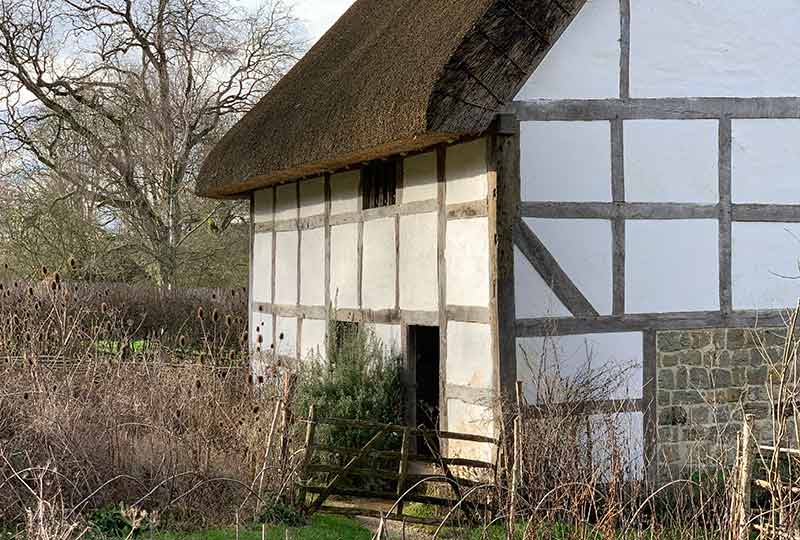
A Wasteland Cottage
Built on land at the edge of Washington common, this cottage may or may not originally have had manorial approval.

Landless Labourers
Poplar Cottage was the home of a family who had no land, so access to commons was important.

Hip & Gable
Poplar Cottage is a distinctive shape, with a gable at the ‘smoke bay’ end and hipped roof at the other end.



